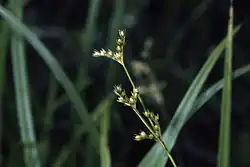Juncus secundus
| Juncus secundus | |
|---|---|

| |
| Inflorescence | |
| Scientific classification | |
| Kingdom: | Plantae |
| Clade: | Tracheophytes |
| Clade: | Angiosperms |
| Clade: | Monocots |
| Clade: | Commelinids |
| Order: | Poales |
| Family: | Juncaceae |
| Genus: | Juncus |
| Species: | J. secundus
|
| Binomial name | |
| Juncus secundus | |
| Synonyms[1] | |
|
Juncus tenuis var. secundus (P.Beauv. ex Poir.) Engelm. | |
Juncus secundus, the lopsided rush, one-sided rush, or second rush, is a species of flowering plants in the family Juncaceae. It is native to eastern North America and has been introduced to Primorsky Krai in Russia.[1][2] It is typically found in serpentine, granite, and other barrens.[3][4]
References
- ^ a b "Juncus secundus P.Beauv. ex Poir". Plants of the World Online. Royal Botanic Gardens, Kew. Retrieved 2 January 2023.
- ^ "Juncus secundus P. Beauv. ex Poir. lopsided rush". PLANTS Profile. USDA Natural Resources Conservation Service. Archived from the original on January 2, 2023. Retrieved 2 January 2023.
- ^ Pennell, Francis W. (1912). "Further Notes on the Flora of the Conowingo or Serpentine Barrens of Southeastern Pennsylvania". Proceedings of the Academy of Natural Sciences of Philadelphia. 64: 520–539. JSTOR 4063481.
- ^ Chester, Edward W. (2009). A Fifth Checklist of Tennessee Vascular Plants. ISBN 9781889878263.